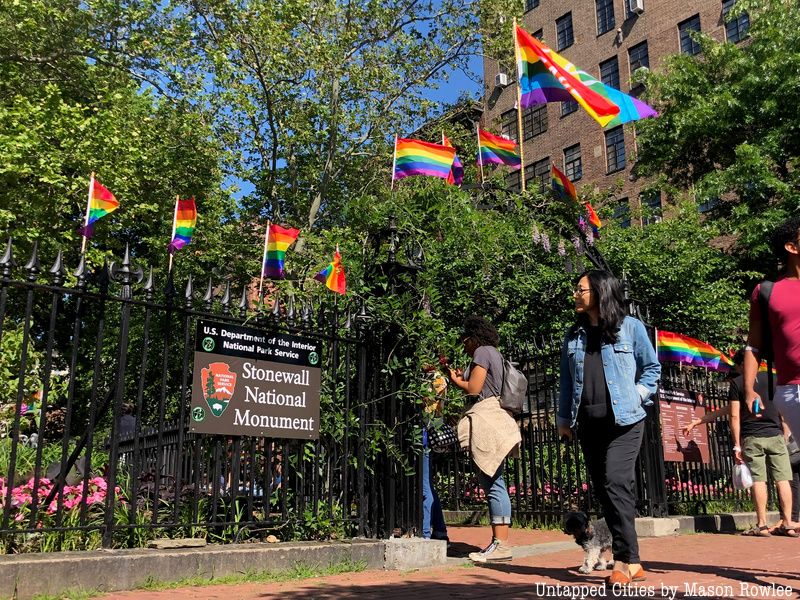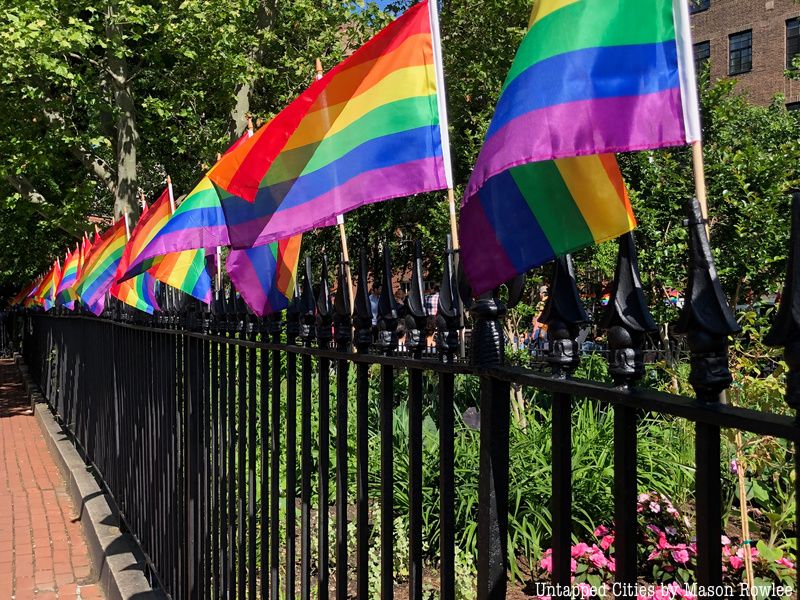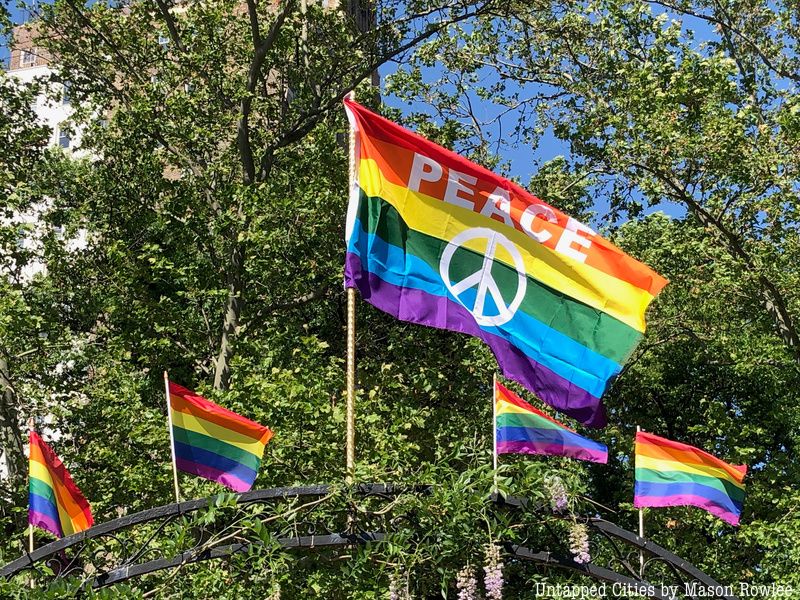Last Chance to Catch NYC's Holiday Notalgia Train
We met the voices of the NYC subway on our nostalgia ride this weekend!


Although LGBTQ Pride boasts one of New York City’s biggest parades, some may be unaware of the historic New York City event that inspired Pride celebrations around the world. The Stonewall Riots—a defining moment in both American and LGBTQ history—occurred on June 28, 1969 at The Stonewall Inn on Christopher Street in Manhattan, sparking a legacy of Pride-themed events throughout the month of June in New York City and beyond. The bar and surrounding parks have since been deemed a National Monument, but the rest of the surrounding area of the West Village shares the Stonewall’s rich history, one which helped shape the culture of New York City well before the riots. This year marks the 50th anniversary of the Stonewall Riots, and as the last weekend of Pride Month approaches, we take a look back to the events of 1969.
In the 1960s, expressions of LGBTQ individuality were under attack by many lawmakers within New York City. At the time, any solicitation of homosexual relations was illegal within the city, and police officers were allowed to arrest any individual who wore as little as three articles of clothing that were deemed “indecent.” Furthermore, the gay community was not allowed to assemble in large groups due to laws which forbade dancing and queer expression in public. These restrictions led to the development of many safe spaces in the city, including the Stonewall Inn, where these laws were circumvented.
In 1966, the Genovese crime family—infamous for their status as one of the five big families in the New York Mafia—purchased the Stonewall Inn and converted it into a “bottle bar,” which allowed the establishment to operate without a liquor license because patrons were expected to bring their own alcohol. With the help of some alleged bribes to the New York Police Department, the Genovese family was also able to bypass many of the laws designed to oppress LGBTQ expression.

Although the Stonewall Inn served as a safe space for the queer community, the Genovese family was not always allies to the community. Upon entry, patrons were expected to write their names in entrance books. Many of the wealthier attendees were later blackmailed by the Genovese family for money, if they wished to keep their sexuality/gender identity a secret. For most of the bar’s customers, however, the Stonewall Inn was a liberated space which allowed freedom of expression.
Even within the 1960s queer community, drag queens and drag performers were often heavily stigmatized and, as a result, were not welcome in many queer spaces. At Stonewall, drag queens were welcomed and dancing was encouraged. Many smaller queer spaces of refuge did not allow dancing or drag performances because of their hope to remain ambiguous; however, Stonewall’s relationship to the Mafia allowed much more freedom of expression. For gay runaways and starving artists, Stonewall became a haven in 1960s New York.
Even in paradise, however, the safety of many patrons was still at risk. Raids by the New York City Police were commonplace, though the connection of the Genovese family allowed most patrons to be tipped-off about the raids before they occurred. On June 28, 1969, New York Police raided the Stonewall Inn without any tip-off. With warrants in hand, police officers stormed the bar and hoped to arrest as many of the 200 individuals at Stonewall that evening as possible. During raids, patrons became tired of the constant police brutality used against them, and at 1:00 A.M., started to fight back.

The Stonewall Riots began when a lesbian woman was being escorted out of the bar and used a billy-club to assault a police officer who failed to loosen her handcuffs. The police officer assaulted the women and threw her into a police wagon. This served as the last straw for the gay community, and soon after the 200 people present began to throw pennies, beer bottles, and eventually, bricks at police vehicles and the Stonewall Inn.
By 4:00 A.M., Christopher Street was littered with glass and debris as the streets began to clear. Thirteen people were arrested by police and four police officers were hospitalized that first evening of protesting. On the second night, the riots grew and more LGBTQ activists throughout Greenwich Village assembled to fight against the police brutality. By the third and final evening, over 1,000 protestors had assembled, and five more people were arrested.
These three days of riots sent out a signal to the entirety of law enforcement: no longer was the New York gay community going to be abused by law enforcement. The Stonewall Riots have been hailed as a galvanizing moment in the history of the gay rights movement, which ignited a sense of action within the gay community. Proceeding the riots, many activist groups began, such as the Gay Liberation Front, Human Rights Campaign, Parents and Friends of Lesbians and Gays (PFLAG), and Gay and Lesbian Alliance Against Defamation (GLAAD).

In June 2015, the Stonewall Inn was declared a New York City landmark by the New York Landmarks Preservation Commission for its significance in advancing civil rights and the building’s history as a reminder of the struggle for equality. Separately, it also listed on the State and National Registers of Historic Places, the first inclusion of a LGBTQ historic site. Being the first of its kind, Stonewall signified a movement toward the recognition of inclusive history—a move that was instrumental in gaining mainstream attention for the importance of preserving LGBTQ history. The inclusion of Stonewall as a national monument has opened discussion about inclusivity in American history, since many public schools still do not include LGBTQ history in their curriculum.
The landmarking of Stonewall caught the attention President Barack Obama, and in 2016 he declared the Stonewall Inn a national monument. “Stonewall will be our first national monument to tell the story of the struggle for LGBT rights,” said President Obama at the Stonewall Inn’s induction as a national monument. “I believe our national parks should reflect the full story of our country, the richness and diversity and uniquely American spirit that has always defined us.”
Today, the Stonewall Inn operates as both a gay bar and a national historic landmark for the gay rights movement. It continues to inspire new generations and this year will be celebrating the 50th anniversary of the Stonewall Riots. To learn more about Stonewall, make sure to check out Untapped Cities’ guided walkthrough of Stonewall 50 at the New-York Historical Society and the exhibition about Stonewall in a hidden gallery atop the Manhattan Municipal Building.
Next check out A Guide to NYC Pride 2019: 25 Events to Check Out This Month
Subscribe to our newsletter